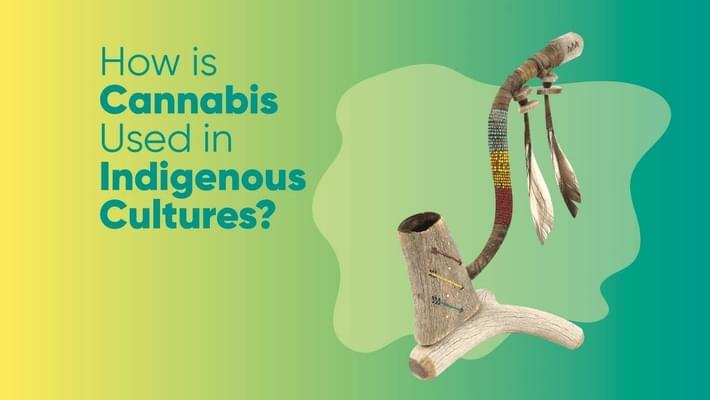
How is Cannabis Used in Indigenous Cultures?
Published on 10/9/22
While those who work a corporate life may enjoy an extra holiday of PTO around Indigenous Peoples' Day, Native Americans have fought to gain respect from Americans across the country. Many people may wonder if native people used cannabis, and if they did, how did they use it? Here's what you need to know about Indigenous Peoples' Day, Native Americans, and their history with cannabis.
What is Indigenous Peoples' Day?
In 2021, President Joe Biden proclaimed October 11 as Indigenous Peoples' Day as a day to celebrate the vibrant and diverse cultures and communities of Native Americans that safeguarded land, language, spirit, knowledge, and traditions over generations.
Celebrated on the second Monday in October, Indigenous Peoples' Day began as a counter-celebration of the federal holiday of Columbus Day. Columbus Day commemorates the anniversary of Columbus's arrival in America on October 12, 1492. Those who reject Columbus Day as a holiday cite Columbus as a representation of "the violent history of the colonization in the Western Hemisphere."
Berkeley, California, was the first city to celebrate Indigenous Peoples' Day in 1992 on the 500th celebration of Columbus's arrival in America. Today 15 states and Washington, D.C., celebrate Indigenous Peoples' Day instead of or in addition to Columbus Day.
History of Cannabis and Native Cultures
Just like today, indigenous people used cannabis for many purposes, from anxiety to pain management to simply enjoying the euphoric high that cannabis provides.
Natives have a unique history with cannabis. Many cultures have "teaching plants" in which ceremonial herbs are used. Still, nearly every one of these herbs has been illegal at some point in the United States, including salvia, peyote, mullen, mints, and sage - all ultimately byproducts of the racist roots of the War on Drugs.
Many tribes consider cannabis to be an ancient herb, like the First Nation tribe that uses it in rituals or other tribes who claim visionaries used it with sacred pipes. Other tribes, like the Dakota and Lakota tribes, do not use cannabis as part of their rituals today, but some did use the plant in the past as medicine.
Early natives recognized the potential that cannabis has as medicine, just like many people do today. Indigenous Americans used cannabis in many forms as a stimulant and psychological aid to treat gas, gout, joint or muscle pain, muscular atrophy, skin conditions and so much more.
Of course, the cannabis of today is much different than the cannabis of the past. Today, we have thousands of different strains with THC levels that regularly reach 30%. In the past, cannabis more closely resembled what we think of today as hemp. Native Americans used the plant in many different ways, including rope and textiles. Hemp is a very strong fiber, making it great for ropes and clothing. People saw the potential that hemp has environmentally for products like clothing, paper - even plastic or fuel!
Where did Native Cannabis Come From?
As for where old-world cannabis came from, there are a few different theories of thought on how native cultures actually got their weed. The first theory is that Native Americans had cannabis and hemp before the New World was established when humans crossed the Bering Strait from Asia - where cannabis originated. Since humans were regularly using cannabis in Asia, there's no reason why they wouldn't bring it along with them to the New World, especially with its importance for wood, fiber, and fuel. Many studies and archeological findings support this theory, as some of the earliest evidence of hemp in the Americas comes from the ancient moundbuilders of the Great Lakes and the Mississippi Valley.
Others believe that cannabis never completed the journey across the Bering Strait, and it wasn't brought to the Americas until Portuguese slave traders brought cannabis-consuming slaves from Angola to Brazil and introduced the plant to South America. Spanish colonists introduced the plant to Columbia, Chile, and Mexico, and finally, the British Colonists introduced it to the indigenous people of America.
Additionally, native cultures have legends that cannabis was brought to them by other beings. Native Mexican tribes regard cannabis as a sacred gift from Rosa Maria or Santa Rosa. To these tribes, cannabis is not just a plant but a deity from God's heart. Additionally, tribes in Veracruz use cannabis as part of a curing ceremony. In North America, some tribes follow the legend that cannabis was brought to us by the "Star People," which populated the world with humanity and thought cannabis was necessary for survival.
Native Americans and Cannabis Today
While Native American culture still has a place for cannabis and its many uses, not all tribes are on the wave of acceptance. While tribes like the Lakotas used to use the plant's sap to remove warts, they currently oppose the use of cannabis today - same with the Dakota tribe. Modern Cherokees don't allow for the use of medical or recreational cannabis use either.
As of 2015, 84% of federally recognized tribes reside in states where medical marijuana is legal, but the majority of tribal codes criminalize marijuana possession and trafficking. Only a few select tribes have legalized sales, typically when the state their land resides in has also legalized it.
While today, indigenous tribes vary in their cannabis use, it shows the diversity of indigenous cultures across North America and even the world.
